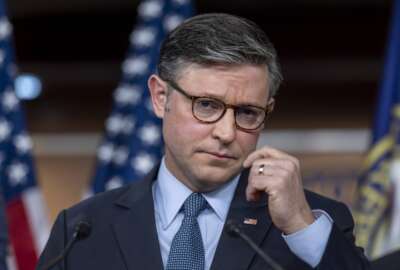Army to update its ‘institutional’ organization
Secretary John McHugh announced the creation of a new commission to revamp the part of the Army that prepares, trains, educates and supports troops. He said this...
By Jason Miller
Executive Editor
Federal News Radio
The Army is transforming in yet another way.
Secretary John McHugh today announced a new group, called the Institutional Army Transformation Commission, would be tasked with looking at a part of the service that hasn’t changed considerably in more than 30 years. The commission will find new ways to make the service a more “agile, cost-effective organization,” he added.
“We’re not just asking people to change the way they budget,” McHugh said today during a town hall with members of the Senior Executive Service. “We’re asking them to change the way they think.”
The Institutional Army Transformation Commission will focus on the service’s institutional part. McHugh said the Army is basically split into two separate organizations: the operational Army, made up of deployed forces, currently in the fight in Afghanistan and Iraq; and the institutional Army, or the generating force, which prepares, trains, educates and supports those troops.
McHugh said the operational Army has changed dramatically over the last decade, while the institutional Army looks the same way as it did since the early 1970s.
Leonard Braverman, technical director in the Office of the Deputy Under Secretary of the Army, will lead the commission, which will focus on organizational change, analysis of efficiency assertions, and implementation and integration of the reforms that have been previously approved to improve departmental decision processes, analytic capabilities and information transparency.
McHugh said the commission should have open access to and work closely with the Office of Business Transformation.
“The commission will be limited to 15 members from across the Army,” McHugh said. “The director of the Army Staff will ensure that only the most qualified personnel are selected for assignment to the commission and that all possess the skill sets and expertise required. I will also consider limited numbers of additional personnel from the private sector.”
This latest effort follows others looking at short- and long-term improvements within the institutional Army.
McHugh said so far the task force launched efforts to root out overlap and redundancies in research and development, review temporary organizations and task forces to see if they still are needed, consolidate and streamline the requirements process, reform installations management, optimize Army acquisitions and make changes in human capital management.
“While I’ve been encouraged by the task force’s early work, the simple fact is that large-scale institutional transformation takes years to mature before agile, cost-effective organizations emerge — with a culture of continuous improvement incorporated in all activities,” McHugh said. “This commission will implement changes already identified through the short-term task force, assess and identify new opportunities, and continue to function for the next three years. This longer term, more enduring approach is historically and practically necessary and will help make continuous transformation a part of Army culture.”
McHugh said the near-term improvements could save the Army more than $10 billion a year by the end of fiscal 2017.
“Historically, large-scale institutional transformation efforts have taken years to mature before agile, cost-effective organizations emerge with a culture of continuous improvement incorporated in all activities,” McHugh said in his speech. “Likewise, our Institutional Army transformation initiative must be enduring. Momentum of this effort will continue for at least the next three years, with continuity of leadership, purpose and direction.”
All across the Defense Department, the services and DoD agencies are under pressure to reduce costs.
In January, then-Defense Secretary Robert Gates, who initiated these efficiency reviews, said DoD will cut $100 billion from unnecessary and redundant operational activities over the next five years, and reinvest $72 billion of that into mission needs.
RELATED STORIES:
Army teeing up acquisition reforms
Army asserts progress on acquisition reforms
Operating costs will eat into DoD efficiency savings
This story is part of Federal News Radio’s daily DoD Report. For more defense news, click here.
(Copyright 2011 by FederalNewsRadio.com. All Rights Reserved.)
Copyright © 2025 Federal News Network. All rights reserved. This website is not intended for users located within the European Economic Area.





